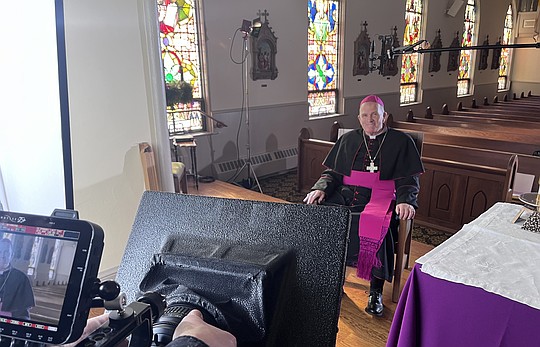Barcelona rejoices as famed architect Antoni Gaudí is declared venerable
April 15, 2025 at 4:20 p.m.

MADRID OSV News – In a a joyful milestone for the Church and lovers of sacred art, Pope Francis declared famed Spanish architect Antoni Gaudí venerable April 14, recognizing his heroic virtues in a decree announced during a Vatican audience with Cardinal Marcello Semeraro. Best known for designing Barcelona's Sagrada Familia, Gaudí dedicated over 40 years of his life to the masterpiece, now seen as both a symbol of faith and an icon of transcendent beauty.
 Pope Francis declared famed Spanish architect Antoni Gaudí venerable April 14, 2025, recognizing his heroic virtues in a decree announced during a Vatican audience with Cardinal Marcello Semeraro. Gaudí (1852-1926) is pictured in an undated portrait. (OSV News photo/Pau Audouard Deglaire, Wikimedia Commons)
Pope Francis declared famed Spanish architect Antoni Gaudí venerable April 14, 2025, recognizing his heroic virtues in a decree announced during a Vatican audience with Cardinal Marcello Semeraro. Gaudí (1852-1926) is pictured in an undated portrait. (OSV News photo/Pau Audouard Deglaire, Wikimedia Commons)The news was especially welcomed by the architect's Archdiocese of Barcelona as a major step toward his long-awaited beatification. Sagrada Familia is the archdiocese's Basilica of the Holy Family. Born in 1852, Gaudí started construction when was 31-years-old. The artist died in 1926.
Chiara Curti, an architect and art historian who specializes in architectural heritage and is an expert on Gaudí, considers that the artist and his masterpiece can speak to the postmodern world. The declaration of Gaudí becoming venerable during the Holy Week is something "providential," she told OSV News.
For Gaudí, everything was providential, she said, and it seems as if even the timing of his declaration as venerable had been "deliberately" chosen. She has felt that Gaudí "has always accompanied me" throughout her career as an artist, and she emphasized the importance of sharing his heritage with the world.
The way Gaudí "lived his faith can be an example for many," because now it will no longer remain "an intimate reflection," but will become "a choral song" of people who will come to know him and pray to him, Curti said.
It is estimated that the Sagrada Familia will be completed within the next few years, and discussions have already begun about who will design the long-awaited Glory Facade.
Meanwhile, construction is progressing on the tower dedicated to Jesus Christ, which is expected to be completed in 2026, coinciding with the centenary of Gaudí's death. Three artists have been named for consideration for the Glory Facade, as announced by the Junta Constructora del Temple Expiatori de la Sagrada Família – a private non-profit responsible for the construction: painter Miquel Barceló, winner of the Asturias prize in 2003, and two sculptors, Cristina Iglesias of Spain and Javier Marín of Mexico.
The Glory Facade has remained unfinished despite having been started in 1882 by Gaudí.
Along with the construction of the tower of Jesus Christ – which will include an observation deck at the top – the columns that will support the Glory Facade are also being finalized.
For Curti, anyone who continues Gaudí's work must be willing to "grow in faith" while the Sagrada Familia grows. Their involvement in the project should not be driven by self-affirmation, but assumed with the responsibility of understanding that they are continuing "a work that is not their own" and that, in this process, it is equally essential to "grow as people while it is being carried out."
Gaudí understood this well, Curti explained. He began the project out of a sense of responsibility toward the promoters, but over time this responsibility was transformed into a commitment to God. Curti considers the Sagrada Familia "a mystical work" because it connects with transcendence, and Gaudí saw himself simply as the "custodian of a work that is not his own."
An example of this attitude can be found in the schools he designed. The schools were built in 1909 with the aim to provide education to the children from the neighborhood surrounding the basilica, as well as to the children of the workers involved in its construction.
According to Curti, "two qualities define the attitude of the true creator: building with love, both for oneself and in service to others." He saw himself as an "instrument, someone who accompanied the growth of something that transcended him." He was fully aware that he would never see the work completed, she said.
Gaudí created many unique projects, such as the famed Barcelona house Casa Batllo, but he eventually renounced secular art.
Throughout this inner journey, as Gaudí grew older, "his faith became increasingly simple and essential," like the faith of "a child who recognizes his divine filiation," Curti said.
The architect would even avoid "dialoguing with intellectuals, not out of rejection of thought, but because he knew himself, above all, as a child of God, and whoever lives with that awareness is placed precisely in the wonder of one who contemplates the greatness of his Creator," she said.
Even so, it is important to consider that Gaudí's work is also a song to postmodernity, a reminder that human beings "always tend toward transcendence, and the beauty of his work makes it possible," Curti pointed out.
In observing the tourists who walk through the Sagrada Familia, "you realize that many people are deeply moved by the beauty expressed" by the Church, a needed beauty that "can speak to the world" because people need "someone to connect us with that transcendence," she said.
Rocio Franch Oviedo writes for OSV News from Madrid.
The Church needs quality Catholic journalism now more than ever. Please consider supporting this work by signing up for a SUBSCRIPTION (click HERE) or making a DONATION to The Monitor (click HERE). Thank you for your support.
Related Stories
Tuesday, December 23, 2025
E-Editions
Events
MADRID OSV News – In a a joyful milestone for the Church and lovers of sacred art, Pope Francis declared famed Spanish architect Antoni Gaudí venerable April 14, recognizing his heroic virtues in a decree announced during a Vatican audience with Cardinal Marcello Semeraro. Best known for designing Barcelona's Sagrada Familia, Gaudí dedicated over 40 years of his life to the masterpiece, now seen as both a symbol of faith and an icon of transcendent beauty.
 Pope Francis declared famed Spanish architect Antoni Gaudí venerable April 14, 2025, recognizing his heroic virtues in a decree announced during a Vatican audience with Cardinal Marcello Semeraro. Gaudí (1852-1926) is pictured in an undated portrait. (OSV News photo/Pau Audouard Deglaire, Wikimedia Commons)
Pope Francis declared famed Spanish architect Antoni Gaudí venerable April 14, 2025, recognizing his heroic virtues in a decree announced during a Vatican audience with Cardinal Marcello Semeraro. Gaudí (1852-1926) is pictured in an undated portrait. (OSV News photo/Pau Audouard Deglaire, Wikimedia Commons)The news was especially welcomed by the architect's Archdiocese of Barcelona as a major step toward his long-awaited beatification. Sagrada Familia is the archdiocese's Basilica of the Holy Family. Born in 1852, Gaudí started construction when was 31-years-old. The artist died in 1926.
Chiara Curti, an architect and art historian who specializes in architectural heritage and is an expert on Gaudí, considers that the artist and his masterpiece can speak to the postmodern world. The declaration of Gaudí becoming venerable during the Holy Week is something "providential," she told OSV News.
For Gaudí, everything was providential, she said, and it seems as if even the timing of his declaration as venerable had been "deliberately" chosen. She has felt that Gaudí "has always accompanied me" throughout her career as an artist, and she emphasized the importance of sharing his heritage with the world.
The way Gaudí "lived his faith can be an example for many," because now it will no longer remain "an intimate reflection," but will become "a choral song" of people who will come to know him and pray to him, Curti said.
It is estimated that the Sagrada Familia will be completed within the next few years, and discussions have already begun about who will design the long-awaited Glory Facade.
Meanwhile, construction is progressing on the tower dedicated to Jesus Christ, which is expected to be completed in 2026, coinciding with the centenary of Gaudí's death. Three artists have been named for consideration for the Glory Facade, as announced by the Junta Constructora del Temple Expiatori de la Sagrada Família – a private non-profit responsible for the construction: painter Miquel Barceló, winner of the Asturias prize in 2003, and two sculptors, Cristina Iglesias of Spain and Javier Marín of Mexico.
The Glory Facade has remained unfinished despite having been started in 1882 by Gaudí.
Along with the construction of the tower of Jesus Christ – which will include an observation deck at the top – the columns that will support the Glory Facade are also being finalized.
For Curti, anyone who continues Gaudí's work must be willing to "grow in faith" while the Sagrada Familia grows. Their involvement in the project should not be driven by self-affirmation, but assumed with the responsibility of understanding that they are continuing "a work that is not their own" and that, in this process, it is equally essential to "grow as people while it is being carried out."
Gaudí understood this well, Curti explained. He began the project out of a sense of responsibility toward the promoters, but over time this responsibility was transformed into a commitment to God. Curti considers the Sagrada Familia "a mystical work" because it connects with transcendence, and Gaudí saw himself simply as the "custodian of a work that is not his own."
An example of this attitude can be found in the schools he designed. The schools were built in 1909 with the aim to provide education to the children from the neighborhood surrounding the basilica, as well as to the children of the workers involved in its construction.
According to Curti, "two qualities define the attitude of the true creator: building with love, both for oneself and in service to others." He saw himself as an "instrument, someone who accompanied the growth of something that transcended him." He was fully aware that he would never see the work completed, she said.
Gaudí created many unique projects, such as the famed Barcelona house Casa Batllo, but he eventually renounced secular art.
Throughout this inner journey, as Gaudí grew older, "his faith became increasingly simple and essential," like the faith of "a child who recognizes his divine filiation," Curti said.
The architect would even avoid "dialoguing with intellectuals, not out of rejection of thought, but because he knew himself, above all, as a child of God, and whoever lives with that awareness is placed precisely in the wonder of one who contemplates the greatness of his Creator," she said.
Even so, it is important to consider that Gaudí's work is also a song to postmodernity, a reminder that human beings "always tend toward transcendence, and the beauty of his work makes it possible," Curti pointed out.
In observing the tourists who walk through the Sagrada Familia, "you realize that many people are deeply moved by the beauty expressed" by the Church, a needed beauty that "can speak to the world" because people need "someone to connect us with that transcendence," she said.
Rocio Franch Oviedo writes for OSV News from Madrid.
The Church needs quality Catholic journalism now more than ever. Please consider supporting this work by signing up for a SUBSCRIPTION (click HERE) or making a DONATION to The Monitor (click HERE). Thank you for your support.









